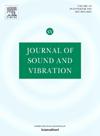Bayesian emulation for forecasting modal frequencies under multivariate environmental variability with data association metric and incremental updating
IF 4.3
2区 工程技术
Q1 ACOUSTICS
引用次数: 0
Abstract
Accommodating the influence of Environmental and Operational Variability (EOV) on modal parameters has been a critical issue in Structural Health Monitoring (SHM). In this study, a Bayesian predictive model incorporating data association metric and incremental updating scheme is proposed to forecast the variability of modal frequencies under EOV. Fast Bayesian Operational Modal Analysis (FBOMA) is firstly employed to identify the modal properties. Based on the training data set of identified modal frequencies and multivariate Environmental and Operational Parameters (EOPs), Maximal Information Coefficient (MIC) as an efficient data association metric capable of capturing a wide range of associations is employed to measure their dependence, thereby screening out the factors with the largest correlation. Subsequently, Bayesian emulator providing a nonlinear surrogate mapping between the probability spaces of the modal frequencies and multivariate EOPs is established as a predictive model to forecast the Most Probable Values (MPVs) and associated uncertainties of modal frequencies due to arbitrary EOV. The approach constantly adapts the new field measurements to incrementally update the predictive model and improve the prediction accuracy. The case study using long-term monitoring of the Z24-Bridge demonstrates the superior prediction accuracy of the proposed scheme. Also, the proposed probabilistic input-output modelling scheme has the potential of distinguishing the variations of frequencies due to damage and EOV. This work provides a new possibility for simultaneously accommodating coupling effect of multivariate factors, nonlinear relationship, and multiple uncertainties.
基于数据关联度量和增量更新的多变量环境下模态频率的贝叶斯仿真
适应环境和运行变异性对模态参数的影响是结构健康监测(SHM)中的一个关键问题。本文提出了一种结合数据关联度量和增量更新方案的贝叶斯预测模型来预测EOV下模态频率的变化。首先采用快速贝叶斯操作模态分析(FBOMA)来识别模态特性。基于已识别模态频率和多变量环境与运行参数(EOPs)的训练数据集,采用最大信息系数(MIC)作为一种能够捕获广泛关联的有效数据关联度量来衡量它们之间的相关性,从而筛选出相关性最大的因素。在此基础上,利用贝叶斯仿真器建立了模态频率概率空间与多变量EOPs之间的非线性替代映射,作为预测模型,预测任意EOV引起的模态频率最可能值(mpv)及相关不确定性。该方法不断适应新的现场测量结果,逐步更新预测模型,提高预测精度。通过对z24大桥的长期监测,验证了该方案具有较高的预测精度。此外,所提出的概率输入输出建模方案具有区分由于损伤和EOV引起的频率变化的潜力。这为同时适应多元因素、非线性关系和多重不确定性的耦合效应提供了新的可能性。
本文章由计算机程序翻译,如有差异,请以英文原文为准。
求助全文
约1分钟内获得全文
求助全文
来源期刊

Journal of Sound and Vibration
工程技术-工程:机械
CiteScore
9.10
自引率
10.60%
发文量
551
审稿时长
69 days
期刊介绍:
The Journal of Sound and Vibration (JSV) is an independent journal devoted to the prompt publication of original papers, both theoretical and experimental, that provide new information on any aspect of sound or vibration. There is an emphasis on fundamental work that has potential for practical application.
JSV was founded and operates on the premise that the subject of sound and vibration requires a journal that publishes papers of a high technical standard across the various subdisciplines, thus facilitating awareness of techniques and discoveries in one area that may be applicable in others.
 求助内容:
求助内容: 应助结果提醒方式:
应助结果提醒方式:


